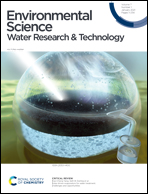Simple method to quantify extraneous water and organic matter degradation in sewer networks†
Abstract
The quantity and quality of sewage in sanitary sewer systems can be heavily affected by extraneous water such as rainfall-runoff and groundwater, as well as the degradation of organic materials along sewer pipelines, which would lead to ultra-low influent concentrations of organic matter and much larger wastewater treatment volumes for wastewater treatment plants (WWTPs). Herein, we developed a simple method to quantify the amount of extraneous water and the organic matter degradation in sewer networks based on the balance model of water flow and pollutant loads—total phosphorus (TP) and chemical oxygen demand (COD)—between the entrance and exit of the sewer pipe network. Several important indicators reflecting the performance of the sewer systems, including collected sanitary sewage, groundwater infiltration, rainfall-runoff inflow, and the overall COD degradation rate, can be easily quantified. This method was used to estimate the function of two different sewer systems (system 1 and system 2) near Lake Erhai in Yunnan Province, China. The results successfully revealed the variations in the indicators, which were consistent with the theoretical analysis results and the observations. The results can provide guidance for the operation and management of sewer systems and WWTPs, as well as for the analysis of the environmental benefits of sewer systems. Moreover, the results can be used in designing new sewer systems in similar rural areas.



 Please wait while we load your content...
Please wait while we load your content...